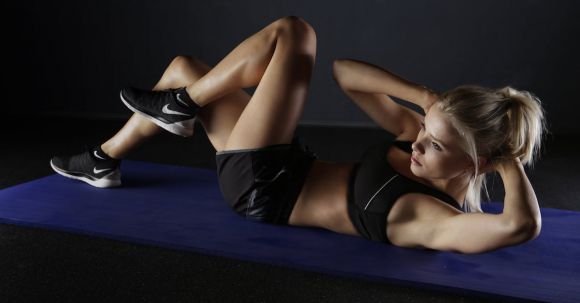Every athlete knows that to excel in their chosen sport, they need to train consistently and effectively. But what if there was a way to take your training to the next level? That's where sports-specific training comes in. By tailoring your workouts to mimic the movements and demands of your sport, you can enhance your performance and take your game to new heights. In this article, we'll explore the benefits of sports-specific training and how you can incorporate it into your routine.
Blog Posts
Cardio workouts are a great way to burn calories and improve cardiovascular fitness. Whether you enjoy running, cycling, dancing, or any other form of aerobic exercise, there are several strategies you can use to maximize your calorie burn and get the most out of your cardio sessions. In this article, we will explore some effective tips to help you achieve your fitness goals.
Choose High-Intensity Interval Training (HIIT)
High-intensity interval training (HIIT) is a type of cardio workout that involves alternating between short bursts of intense exercise and periods of recovery. This method has been shown to be highly effective for calorie burn and can help you achieve results in less time. By pushing your body to its limits during the intense intervals, you can significantly increase your metabolic rate and continue burning calories even after the workout is over.Incorporate Resistance Training
While cardio workouts primarily focus on burning calories, incorporating resistance training into your routine can help you build lean muscle mass. Muscle is more metabolically active than fat, meaning that the more muscle you have, the more calories you will burn at rest. By adding strength training exercises such as weightlifting or bodyweight exercises to your cardio routine, you can increase your overall calorie burn and boost your metabolism.Increase the Intensity of Your Workouts
To maximize calorie burn during your cardio workouts, it is important to continuously challenge yourself and increase the intensity of your exercises. This can be done by increasing the speed, resistance, or incline of your workout equipment, or by incorporating more challenging exercises into your routine. By pushing yourself out of your comfort zone, you will burn more calories and continue to make progress towards your fitness goals.Focus on Full-Body Movements
Engaging multiple muscle groups simultaneously during your cardio workouts can help you burn more calories. Instead of focusing solely on exercises that target a specific muscle group, opt for full-body movements that require the use of multiple muscles. Exercises such as burpees, mountain climbers, or kettlebell swings are excellent choices for engaging the entire body and maximizing calorie burn.Stay Consistent and Vary Your Workouts
Consistency is key when it comes to maximizing calorie burn during cardio workouts. Aim for at least 150 minutes of moderate-intensity cardio exercise or 75 minutes of vigorous-intensity exercise per week. Additionally, it is important to vary your workouts to prevent plateaus and keep your body challenged. Try different types of cardio exercises, alternate between HIIT and steady-state cardio, or join group fitness classes to keep your workouts interesting and effective.Stay Hydrated and Fuel Your Body Properly
Proper hydration and nutrition are essential for maximizing calorie burn during cardio workouts. Dehydration can negatively impact your performance and decrease your ability to burn calories. Aim to drink water before, during, and after your workouts to stay hydrated. Additionally, fueling your body with the right nutrients before and after your cardio sessions can help optimize your performance and recovery. In conclusion, maximizing calorie burn during cardio workouts involves incorporating high-intensity interval training, resistance training, and full-body movements into your routine. By continuously challenging yourself, staying consistent, and fueling your body properly, you can achieve your fitness goals and make the most out of your cardio sessions. So lace up your sneakers, hit the gym, and start maximizing your calorie burn today!
Lifting heavy weights can be intimidating, especially if you're new to the gym or have had a bad experience in the past. The fear of injury or embarrassment can hold you back from reaching your fitness goals. However, it's important to remember that lifting heavy weights is not only safe but also incredibly beneficial for building strength and muscle. If you're ready to conquer your fear and take your workouts to the next level, here are some tips to help you overcome your fear of lifting heavy weights.
Start with Proper Technique
One of the main reasons people fear lifting heavy weights is the fear of injury. However, the key to preventing injuries is using proper technique. Before you start lifting heavy, make sure you have a good understanding of the correct form for each exercise. If you're unsure, consider hiring a personal trainer or watching tutorial videos online. Practicing proper technique will not only help you avoid injuries but also improve your confidence in the gym.Progress Gradually
Another reason why people may fear lifting heavy weights is the fear of failure. It's important to remember that everyone starts somewhere, and progress takes time. Instead of jumping straight into heavy lifting, start with lighter weights and gradually increase the load as you become more comfortable and confident. This will not only help you build strength but also allow you to overcome any mental barriers you may have.Focus on Strength, Not Size
Many people are afraid of lifting heavy weights because they're afraid of getting bulky or looking too muscular. However, it's important to understand that lifting heavy weights doesn't automatically mean you'll become a bodybuilder overnight. Building muscle takes time, and the amount of weight you lift is just one factor. Instead of focusing on size, shift your mindset to improving your strength and overall fitness. This will help you stay motivated and overcome any fears related to body image.Find a Supportive Community
Working out with others who share your goals and interests can be incredibly motivating and empowering. Surrounding yourself with a supportive community can help you overcome your fear of lifting heavy weights. Whether it's joining a group fitness class or finding a workout partner, having people who believe in you and push you to do your best can make all the difference. Not only will it boost your confidence, but it will also provide a sense of accountability and encouragement.Challenge Your Negative Thoughts
Fear often stems from negative thoughts and beliefs. If you find yourself thinking things like "I'm not strong enough" or "I'll never be able to lift that," challenge those thoughts. Replace them with positive affirmations and remind yourself of the progress you've already made. Remember that everyone starts somewhere, and with consistent effort and dedication, you can achieve your goals.Conclusion: Embrace the Challenge
Lifting heavy weights can be intimidating, but it's a challenge worth embracing. By starting with proper technique, progressing gradually, focusing on strength rather than size, finding a supportive community, and challenging your negative thoughts, you can overcome your fear and unlock your full potential. Remember, the weight room is a place to grow and improve, and with time and practice, you'll become stronger both physically and mentally. So, don't let fear hold you back—grab those heavy weights and show them who's boss!
Are you tired of doing countless sit-ups at the gym in hopes of achieving that coveted six-pack? Well, you're in luck! You can sculpt your abs right in the comfort of your own home with these effective exercises. No need for fancy equipment or expensive memberships. All you need is determination and a little bit of space. So, let's get started on your journey to rock-solid abs!
Plank Variations
Planks are a fantastic exercise for strengthening your core muscles, including your abs. Start with the basic plank by getting into a push-up position and resting on your forearms. Keep your body in a straight line from head to toe and engage your abs. Hold this position for as long as you can, aiming for at least 30 seconds. Once you've mastered the basic plank, you can challenge yourself with variations. Try side planks to target your obliques, or add leg lifts to engage your lower abs. Remember to maintain proper form and breathe throughout each exercise.Mountain Climbers
Mountain climbers are a dynamic exercise that not only work your abs but also get your heart rate up. Begin in a high plank position, with your hands directly under your shoulders. Bring one knee towards your chest, then quickly switch legs, mimicking a running motion. Keep your core tight and your hips level as you alternate legs. Aim for 30 to 60 seconds of continuous movement.Russian Twists
Russian twists are an excellent exercise for targeting your obliques. Sit on the floor with your knees bent and feet flat on the ground. Lean back slightly, engaging your abs. Hold a weight or a household object with both hands and twist your torso from side to side, touching the object to the ground on each side. Keep your core tight and your back straight throughout the exercise. Aim for 10 to 15 repetitions on each side.Leg Raises
Leg raises are a challenging exercise that really targets your lower abs. Lie flat on your back with your legs extended. Place your hands by your sides or under your glutes for support. Keeping your core engaged, lift your legs straight up towards the ceiling. Slowly lower them back down without touching the ground, and repeat. If this variation is too difficult, you can bend your knees slightly or place your hands under your glutes for extra support. Aim for 10 to 12 repetitions.Reverse Crunches
Reverse crunches effectively target your lower abs. Lie on your back with your legs bent and feet lifted off the ground. Place your hands by your sides for support. Engage your abs as you lift your hips off the ground, bringing your knees towards your chest. Slowly lower your hips back down and repeat. Focus on using your abs to initiate the movement, rather than relying on momentum. Aim for 10 to 15 repetitions. In conclusion, sculpting your abs doesn't require expensive gym memberships or fancy equipment. With these home exercises, you can effectively target your abs and achieve a strong, defined core. Remember to start with proper form, gradually increase the intensity, and listen to your body. Consistency and dedication are key to seeing results. So, start today and get ready to rock those abs!
Maintaining motivation throughout your health journey can be a challenge. It's easy to start strong, but as time goes on, motivation can wane. However, staying motivated is crucial to achieving your goals and living a healthier life. Here are some tips to help you stay motivated on your health journey.
Set Clear Goals
Setting clear goals is essential when it comes to staying motivated. Without a clear direction, it's easy to lose sight of why you started in the first place. Take some time to define your goals and make them specific, measurable, achievable, relevant, and time-bound (SMART). For example, instead of saying, "I want to lose weight," set a goal like, "I want to lose 10 pounds in the next three months by exercising five times a week and eating a balanced diet."Create a Vision Board
Visualizing your goals can be a powerful motivator. Create a vision board by collecting images, quotes, and words that represent your health goals and the lifestyle you want to achieve. Display your vision board somewhere visible, like your bedroom or office, so you can be reminded of your aspirations every day. This visual representation can inspire you to stay on track and make healthier choices.Find an Accountability Partner
Having someone to hold you accountable can significantly impact your motivation. Find a friend, family member, or even a coworker who shares similar health goals and commit to supporting each other. You can exercise together, share healthy recipes, and check in regularly to keep each other motivated and accountable. Knowing that someone is counting on you can be a powerful motivator to stay on track.Track Your Progress
Monitoring your progress can help you stay motivated by showing you how far you've come. Keep a journal or use a fitness app to track your workouts, food intake, and other health-related activities. Seeing your progress in black and white can boost your confidence and keep you motivated to continue making positive changes. Celebrate your milestones along the way to stay motivated and inspired.Reward Yourself
Rewarding yourself for reaching your goals is an excellent way to stay motivated. Set up a reward system where you treat yourself to something special when you achieve a specific milestone. It could be a massage, a new workout outfit, or a weekend getaway. Having something to look forward to can keep you motivated and give you a sense of accomplishment.Stay Positive
Maintaining a positive mindset is crucial to staying motivated on your health journey. Surround yourself with positive influences, whether it's uplifting music, motivational podcasts, or inspiring books. Practice positive affirmations and focus on the progress you've made rather than dwelling on setbacks. Remember that setbacks are part of the process, and every small step forward counts.Mix It Up
Repeating the same routine day after day can lead to boredom and decreased motivation. Keep things fresh and exciting by trying new activities and exercises. Sign up for a dance class, go for a hike, or take up a new sport. Trying new things not only keeps your health journey interesting but also challenges your body and mind in different ways. In conclusion, staying motivated on your health journey is vital to achieving lasting success. Set clear goals, create a vision board, find an accountability partner, track your progress, reward yourself, stay positive, and mix up your routine. Remember, motivation may fluctuate, but by implementing these strategies, you can stay on track and continue making progress towards a healthier and happier you.
Our metabolism plays a crucial role in maintaining a healthy weight and overall well-being. It determines how efficiently our bodies burn calories and convert them into energy. While genetics and age can have an impact on our metabolism, there are certain foods that can help to give it a natural boost. Incorporating these foods into your diet can not only aid in weight management but also improve your overall health. Here are the top 10 foods for boosting your metabolism.
Lean Protein
Protein is a vital nutrient for our bodies, and it has been proven to increase metabolism. Lean protein sources such as chicken, turkey, fish, tofu, and legumes are excellent choices. These foods require more energy to digest, thus increasing your metabolic rate and helping you burn more calories.Green Tea
Green tea is not only a refreshing beverage but also a metabolism booster. It contains a compound called catechin, which has been shown to increase metabolism and fat oxidation. Incorporating a cup of green tea into your daily routine can have a positive impact on your metabolism.Chili Peppers
If you enjoy spicy foods, you're in luck! Chili peppers contain a compound called capsaicin, which gives them their spicy flavor. Capsaicin has been found to increase metabolism and stimulate fat burning. So, adding a dash of chili peppers to your meals can give your metabolism a little extra kick.Whole Grains
Whole grains such as oats, brown rice, quinoa, and whole wheat bread are rich in fiber and complex carbohydrates. These foods take longer to digest, keeping you fuller for longer and preventing spikes in blood sugar levels. This helps to regulate your metabolism and promote healthy weight management.Berries
Berries are not only delicious but also packed with antioxidants and fiber. They have a low glycemic index, meaning they don't cause rapid spikes in blood sugar levels. This helps to keep your metabolism steady and prevent cravings. Blueberries, strawberries, raspberries, and blackberries are excellent choices to include in your diet.Greek Yogurt
Greek yogurt is a protein-rich snack that can help boost your metabolism. It contains probiotics, which are beneficial for gut health and digestion. A healthy gut is essential for a properly functioning metabolism, so incorporating Greek yogurt into your diet can have a positive impact on your overall metabolic rate.Caffeine
If you're a coffee lover, you'll be pleased to know that caffeine can actually increase your metabolism. It stimulates the nervous system and promotes the breakdown of fat cells. However, moderation is key, as excessive caffeine intake can have negative effects on your health. Enjoy your cup of coffee or tea, but remember to consume it in moderation.Leafy Greens
Leafy greens such as spinach, kale, and broccoli are excellent choices for boosting your metabolism. These vegetables are low in calories but high in fiber, making them a great addition to any weight-loss or healthy eating plan. They also contain minerals and vitamins that support your overall health and well-being.Water
Although not a food, water is essential for maintaining a healthy metabolism. Staying hydrated helps your body function optimally and supports the breakdown of fats. Ensure you drink enough water throughout the day to keep your metabolism running smoothly.Spices
Certain spices, such as ginger, cinnamon, and turmeric, have been found to have metabolism-boosting properties. They can increase your metabolic rate and promote fat burning. Adding these spices to your meals not only enhances the flavor but also supports a healthy metabolism. Incorporating these top 10 metabolism-boosting foods into your diet can have a positive impact on your overall health and weight management goals. Remember to focus on whole, nutrient-dense foods and maintain a balanced diet. As always, it's essential to consult with a healthcare professional or registered dietitian before making any significant changes to your diet or exercise routine.
Breakfast is often referred to as the most important meal of the day. It kickstarts our metabolism, fuels our brain, and provides us with the energy we need to tackle the day ahead. However, in the rush of our busy lives, it can be challenging to find the time to prepare a balanced and nutritious breakfast. Luckily, there are plenty of quick and healthy breakfast ideas that can be whipped up in no time. Here are some delicious options to get you started:
Smoothie Bowls: A Burst of Nutrients
Smoothie bowls have gained immense popularity in recent years, and for good reason. They are not only visually appealing but also packed with essential nutrients. To make a smoothie bowl, start by blending a combination of your favorite fruits and vegetables with a liquid of choice, such as almond milk or coconut water. Pour the smoothie into a bowl and top it with a variety of toppings, such as fresh berries, granola, chia seeds, or nuts. Smoothie bowls are not only quick to make but also provide a refreshing and filling start to your day.Overnight Oats: A Time-Saving Delight
If you're looking for a breakfast option that requires minimal effort in the morning, overnight oats are the way to go. Simply combine rolled oats with your choice of milk or yogurt, along with any additional sweeteners or flavorings you desire, such as honey or vanilla extract. Mix everything together in a jar or container and refrigerate overnight. In the morning, your oats will have absorbed the liquid and become soft and creamy. You can top them with fresh fruits, nuts, or a drizzle of nut butter for added taste and texture. Overnight oats are not only convenient but also provide a great source of fiber and whole grains.Egg Muffins: Protein-Packed and Portable
For those who prefer a savory breakfast, egg muffins are an excellent option. They are quick to make and can be easily customized to suit your taste preferences. Start by whisking eggs with a splash of milk and seasonings such as salt, pepper, and herbs. Pour the mixture into a greased muffin tin and add your choice of toppings, such as chopped vegetables, cheese, or cooked bacon. Bake in the oven until the eggs are set and golden. Once cooled, these muffins can be stored in the refrigerator and enjoyed throughout the week. They are not only high in protein but also portable, making them ideal for busy mornings on the go.Greek Yogurt Parfait: Creamy and Filling
Greek yogurt parfaits are not only delicious but also a great way to incorporate a variety of nutritious ingredients into your breakfast. Start by layering Greek yogurt with fresh fruits, such as berries or sliced bananas, in a glass or bowl. Add a sprinkle of granola or nuts for crunch and drizzle with a touch of honey or maple syrup for sweetness. The combination of creamy yogurt, sweet fruits, and crunchy toppings provides a satisfying and balanced breakfast option. Greek yogurt is also an excellent source of protein and probiotics, which promote a healthy gut. In conclusion, a quick and healthy breakfast is within reach, even on the busiest of mornings. Smoothie bowls, overnight oats, egg muffins, and Greek yogurt parfaits are just a few examples of the many options available. By incorporating these nutritious breakfast ideas into your routine, you can start your day on a nourishing and energizing note. So, ditch the excuses and give these quick and healthy breakfast ideas a try. Your body and mind will thank you!
When it comes to working out, having the right shoes is essential. Not only do they provide support and stability, but they can also prevent injuries and improve your overall performance. With so many options to choose from, finding the perfect pair of workout shoes can be overwhelming. To help you make the right choice, here are some tips for finding the right workout shoes for your feet.
Understand Your Foot Type
Before you start shopping for workout shoes, it's important to understand your foot type. There are three common foot types: flat feet, high arches, and neutral arches. Flat feet have little to no arch, high arches have a noticeable arch, and neutral arches fall somewhere in between. Knowing your foot type will help you choose shoes that provide the right amount of support and cushioning.Consider Your Workout Activities
Different workout activities require different types of shoes. If you're a runner, you'll need shoes with good shock absorption and cushioning. If you're into weightlifting, you'll need shoes with a flat and stable sole for better balance and support. Consider the type of workouts you do most frequently and choose shoes that are specifically designed for those activities.Get Fitted Properly
One common mistake people make when buying workout shoes is not getting properly fitted. It's important to have your feet measured by a professional to determine your correct shoe size. Keep in mind that your shoe size may vary depending on the brand, so try on a few different sizes and styles to find the best fit.Try Them On and Test Them Out
Once you have a few pairs of shoes that meet your criteria, try them on and test them out. Walk around the store, do some squats or lunges, and see how they feel. Pay attention to any areas of discomfort or pressure points. Your shoes should feel comfortable and supportive from the moment you put them on. If they don't feel right, don't hesitate to try another pair.Consider the Shoe's Construction
The construction of the shoe plays a crucial role in its performance and durability. Look for shoes with a supportive midsole that provides cushioning and stability. The outsole should be durable and provide good traction. The upper should be breathable and flexible to allow for natural foot movement. Additionally, consider the weight of the shoe – lighter shoes are generally more comfortable for workouts.Replace Them When Needed
Even the best workout shoes will wear out over time. As a general rule, it's recommended to replace your workout shoes every 300-500 miles or every 6-12 months, depending on how often you use them. Pay attention to any signs of wear and tear, such as worn-out soles, loose stitching, or decreased cushioning. When it's time for a new pair, don't hesitate to invest in quality shoes that will support your feet during workouts. In conclusion, finding the right workout shoes for your feet is crucial for a comfortable and injury-free workout experience. By understanding your foot type, considering your workout activities, getting properly fitted, and testing out different options, you can find the perfect pair of shoes that will support you during your workouts. Remember to pay attention to the shoe's construction and replace them when needed. With the right shoes on your feet, you'll be ready to conquer any workout with confidence.
To excel in any sport, it is crucial to have a training program that is tailored specifically to the demands of that sport. Generic workouts may improve overall fitness, but they will not give you the edge you need to dominate your competition. Sports-specific workouts are designed to target the specific muscles and skills required for your sport, helping you to improve your performance and reach your full potential. In this article, we will explore the benefits of sports-specific workouts and provide some tips on how to incorporate them into your training routine.
Understanding the Importance of Sports-specific Workouts
Sports-specific workouts are designed with the specific movements and requirements of your sport in mind. They focus on improving the skills, strength, endurance, and agility needed for optimal performance. By targeting the specific muscles used in your sport, these workouts can help you develop power, speed, and precision, giving you a competitive advantage.Benefits of Sports-specific Workouts
1. Improved Performance: Sports-specific workouts target the muscles and skills needed for your sport, allowing you to develop the specific attributes required for success. Whether it's explosive power for sprinting, core stability for golf swings, or endurance for long-distance running, these workouts can help you improve your performance in your chosen sport. 2. Injury Prevention: Sports-specific workouts not only improve performance but also help prevent injuries. By strengthening the muscles used in your sport and improving flexibility and mobility, these workouts can reduce the risk of common sports-related injuries. This is particularly important for athletes who engage in high-impact sports or repetitive movements. 3. Mental Focus: Sports-specific workouts not only train your body but also help improve your mental focus. By simulating the movements and challenges of your sport, these workouts can help you develop the mental toughness and concentration needed to perform at your best under pressure.Incorporating Sports-specific Workouts into Your Training Routine
1. Identify the Specific Demands of Your Sport: Start by understanding the specific movements, skills, and physical attributes required for your sport. This will help you design a training program that targets these specific areas. 2. Consult a Professional: If you are new to sports-specific workouts or unsure where to start, it is always a good idea to consult with a professional trainer or coach. They can help assess your current fitness level, identify areas for improvement, and design a personalized training program tailored to your sport. 3. Focus on Strength and Conditioning: Sports-specific workouts often involve a combination of strength training and conditioning exercises. Incorporate exercises that target the muscles used in your sport, such as squats for soccer players or shoulder presses for swimmers. Additionally, include exercises that improve cardiovascular endurance and agility. 4. Include Skill-specific Drills: To further enhance your performance, incorporate skill-specific drills into your training routine. These drills should mimic the movements and challenges of your sport. For example, basketball players can practice shooting and dribbling drills, while tennis players can focus on footwork and stroke technique. 5. Periodize Your Training: To avoid plateauing and ensure continuous improvement, it is important to periodize your training. This involves dividing your training program into specific phases, each with different goals and intensities. For example, you may have a strength-building phase followed by a power and speed phase. By incorporating sports-specific workouts into your training routine, you can take your performance to the next level. Remember to consult with professionals, focus on specific demands, and include a variety of exercises to target both strength and skill development. With dedication and consistency, you can dominate your sport and achieve your athletic goals.
Maintaining a healthy weight is essential for overall well-being, and understanding your daily calorie needs is a crucial step in achieving this goal. By knowing how many calories your body requires each day, you can make informed decisions about your diet and ensure that you are providing your body with the right amount of fuel. In this article, we will explore the simple yet effective methods to calculate your daily calorie needs.









